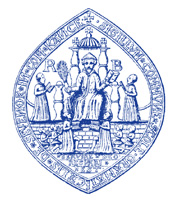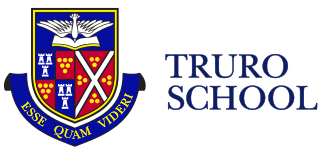
Oswestry is a market town, civil parish and historic railway town in Shropshire, England, close to the Welsh border. It is at the junction of the A5, A483 and A495 roads.

Haberdashers' Adams Grammar School is a selective grammar school for high-achieving boys aged 11-18 and girls aged 16-18 with state boarding for boys only, located in Newport, Shropshire, offering day and boarding education. Current (2021) boarding fees are £12,144 per year and £13,644 per year for overseas students It was founded in 1656 by William Adams, a wealthy member of the Worshipful Company of Haberdashers. In January 2018, the school changed its name to Haberdashers’ Adams, replacing the previous name, Adams' Grammar School (AGS). The school is commonly referred to as Adams Grammar. From 2024, the school will go fully co-ed admitting girls into Year 7.

The Royal Grammar School Worcester is an eleven-eighteen mixed, private day school and sixth form in Worcester, Worcestershire, England. Founded before 1291, it is one of the oldest British independent day schools.

Sevenoaks School is a highly selective coeducational private school in Sevenoaks, Kent, England. It is the second oldest non-denominational school in the United Kingdom, dating back to 1432, only behind Oswestry (1407). Over 1,000 day pupils and boarders attend, ranging in age from 11 to 18 years. There are approximately equal numbers of boys and girls. In 2006 it became the first major UK school to switch entirely from A level exams to the International Baccalaureate. The school is a former member of the G20 Schools group.

Bedford School is a 7–18 boys public school in the county town of Bedford in England. Founded in 1552, it is the oldest of four independent schools in Bedford run by the Harpur Trust. Bedford School is one of the boys' schools in the United Kingdom, and was the winner of the Independent Boys School of the Year Award at the Independent Schools of the Year Awards in 2021.

The King's School, Worcester is an English private day school refounded by Henry VIII in 1541. It occupies a site adjacent to Worcester Cathedral on the banks of the River Severn in the centre of the city of Worcester. It offers mixed-sex mainstream education that follows the UK National Curriculum to around 1,465 pupils aged 2 to 18. At age 11, approximately two thirds of pupils join the senior school from its two prep schools, King's Hawford and King's St Albans, while others come from maintained schools in the city of Worcester and the surrounding areas that include Malvern, Redditch, Kidderminster, Evesham and Pershore.

Oakham School is a public school in Oakham, Rutland, England.

Truro School is a coeducational private boarding and day school located in the city of Truro, Cornwall, England. It is the largest coeducational independent school in Cornwall with over 1050 pupils from pre-prep to sixth form. It is a member school of the Headmasters' and Headmistresses' Conference.

Bloxham School, also called All Saints' School, is a private co-educational day and boarding school of the British public school tradition, located in the village of Bloxham, three miles (5 km) from the town of Banbury in Oxfordshire, England. The present school was founded in 1860 by Philip Reginald Egerton and has since become a member of the Woodard Corporation. The current headmaster is Paul Sanderson, who took over from Mark Allbrook in 2013. The school has approximately 515 pupils.

Founded by King Henry VIII in 1541, The King's School is a state-funded Church of England Cathedral Chorister School located in Peterborough, England. It is the Chorister School for Peterborough Cathedral. Former pupils are known as Old Petriburgians.

Wisbech Grammar School is an 11–18 mixed, Church of England, private day school and sixth form in Wisbech, Isle of Ely, Cambridgeshire, England. Founded by the Guild of the Holy Trinity in 1379, it is one of the oldest schools in the country.

Ermysted's Grammar School is an 11-18 boys' voluntary aided grammar school in Skipton, North Yorkshire, England.

Hutton Grammar School is an 11–18 boys voluntary aided, state-funded Church of England comprehensive day school. It is located 3 miles (4.8 km) south west of Preston, Lancashire, in Hutton, England. It provides education for boys from the age of 11 to 16, and in the Sixth Form for both boys and girls.
Kent College, Canterbury is a co-educational private school for boarding and day pupils between the ages of 3 months and 18 years. It was founded in 1885, and is a member of the Headmasters' and Headmistresses' Conference. Originally established as a boys' public school, it admitted girls into the sixth form in 1973 and since 1975 it has been fully co-educational.

Owen Owen was a Welsh schoolteacher who, after being headmaster of a successful private school for boys in Oswestry, Shropshire, became the first Chief Inspector of the Central Welsh Board for Intermediate Education.

Adcote School is a non-selective independent day and boarding school for girls, located in the village of Little Ness, 5 miles (8.0 km) northwest of Shrewsbury, Shropshire, England. The school was founded in 1907, and is set in a Grade I listed country house built in 1879 for Rebecca Darby, the widow of Alfred Darby I (1807–52) and a great niece of Abraham Darby. The Darbys were the iron-master family who built Ironbridge. The school has a Junior School that takes girls aged 7 to 11, a Senior School for girls aged 11 to 16 and a Sixth Form taking girls from 16 to 19.
Moreton Hall is an independent boarding and day school for girls aged 6 months to 18 and boys aged 6 months to 13, situated in North Shropshire four miles from the market town of Oswestry. Founded in 1913, Moreton Hall celebrated its centenary in 2012/13. Much of the early history of the school is unrecorded, but Michael Charlesworth, chairman of the Governors for twelve years, wrote the "Story of Moreton Hall" to mark the ninetieth anniversary.

Dafydd ab Ieuan, better known by his English name David Holbache, was a Welsh politician, best known for founding Oswestry School in 1407.
Douglas Robert Kenneth Robb is an English schoolmaster who is currently headmaster of Gresham's School. Before that, he was a housemaster at Oundle School and then head of Oswestry School.



















